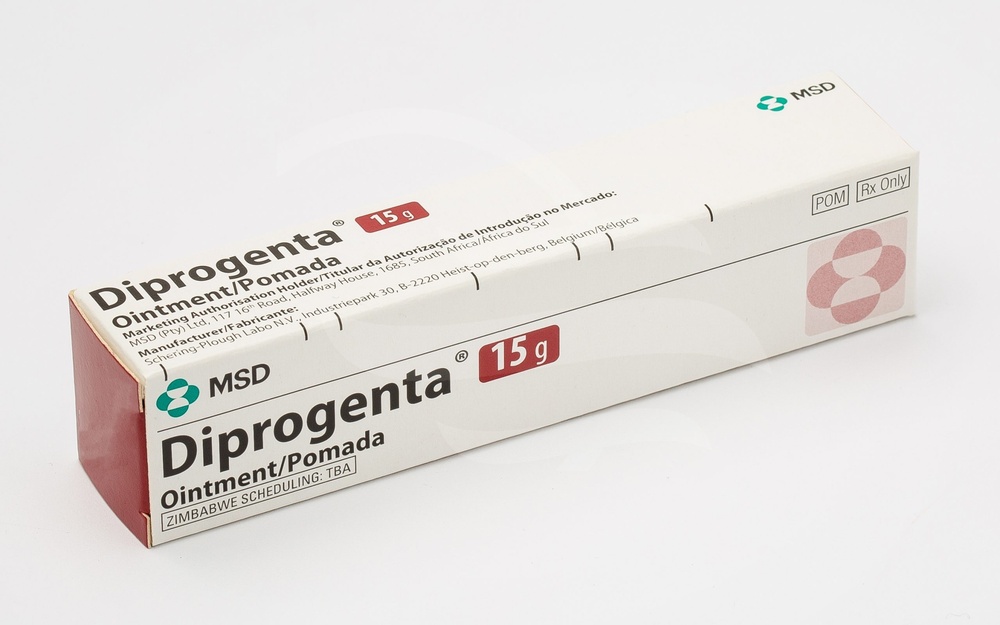

Diprogenta

Ask a doctor about a prescription for Diprogenta

How to use Diprogenta
Leaflet attached to the packaging: patient information
Warning! The leaflet should be kept. Information on the immediate packaging in a foreign language.
Diprogenta
(0.64 mg + 1 mg)/g, ointment
Betamethasone dipropionate + Gentamicin
It is necessary to carefully read the contents of the leaflet before using the medicine, as it contains important information for the patient.
- The leaflet should be kept, so that it can be re-read if necessary.
- In case of any doubts, you should consult a doctor or pharmacist.
- This medicine has been prescribed for a specific person. It should not be given to others. The medicine may harm another person, even if the symptoms of their illness are the same.
- If the patient experiences any side effects, including any side effects not listed in this leaflet, they should inform their doctor, pharmacist, or nurse. See section 4.
Table of contents of the leaflet
What is Diprogenta and what is it used for
Important information before using Diprogenta
How to use Diprogenta
Possible side effects
How to store Diprogenta
Package contents and other information
1. What is Diprogenta and what is it used for
The properties of Diprogenta result from the action of the active substances: betamethasone dipropionate and gentamicin.
Betamethasone dipropionate belongs to the group of corticosteroids with strong action. When used locally, it has a rapid and long-lasting anti-inflammatory, anti-itching, and vasoconstrictive effect.
Gentamicin is an aminoglycoside antibiotic with a broad spectrum of antibacterial action.
Indications
Diprogenta ointment is indicated for the symptomatic treatment of inflammatory skin changes responding to corticosteroids, complicated by secondary infections caused by gentamicin-sensitive microorganisms.
These diseases include: psoriasis, contact dermatitis (toxic dermatitis), atopic dermatitis (childhood eczema, allergic dermatitis), neurodermatitis (chronic simple lichen), lichen planus, eczema (including nummular eczema, hand eczema, eczematous dermatitis), erythema, burns, acute, reactive vesicular eruption on the hands and feet (dyshidrosis), seborrheic dermatitis, exfoliative dermatitis, radiation-induced dermatitis, pigmentation on the basis of venous stasis.
The bacteria sensitive to gentamicin include strains of streptococci (group A: β-hemolytic, α-hemolytic), Staphylococcus aureus (coagulase-positive, coagulase-negative, and some penicillinase-producing strains), as well as Gram-negative bacteria, such as: Pseudomonas aeruginosa,
Aerobacter aerogenes, Escherichia coli, Proteus vulgarisand Klebsiella pneumoniae.
Page 1 5
2. Important information before using Diprogenta
When not to use Diprogenta:
if the patient is allergic to betamethasone dipropionate or gentamicin, or to other corticosteroids, aminoglycoside antibiotics, or to any of the other ingredients of this medicine (listed in section 6);
in viral (e.g., chickenpox, herpes) and fungal skin infections;
in primary bacterial skin infections;
in rosacea;
in acne vulgaris;
on wounds, on damaged skin;
in the anal and genital areas;
in perioral dermatitis;
for a long time;
in children under 2 years of age.
Warnings and precautions
Before starting to use Diprogenta, the patient should discuss it with their doctor or pharmacist.
If irritation, allergy, or infection occurs during treatment, the use of Diprogenta should be discontinued and the patient should contact their doctor, who will provide appropriate treatment.
Long-term use of the medicine may lead to the growth of gentamicin-resistant and other aminoglycoside-resistant microorganisms.
Cross-allergy to aminoglycoside antibiotics has been reported.
Diprogenta should not be used in the eyes or around the eyes, or on mucous membranes.
The absorption of betamethasone dipropionate and gentamicin through the skin increases after using occlusive dressings (e.g., diapers).
During treatment, there is a risk of systemic side effects characteristic of corticosteroids (including adrenal suppression) and gentamicin (such as hearing loss, kidney damage, especially in people with impaired kidney function).
Therefore, the use of the medicine on a large surface area of the body, in large doses, and with occlusive dressings should be avoided.
If the patient experiences blurred vision or other vision disturbances, they should contact their doctor.
Children and adolescents
In children, more often than in adults, suppression of the hypothalamic-pituitary-adrenal axis has been reported after local use of corticosteroids, due to increased absorption resulting from a large skin surface area to body mass ratio.
In children who have used topical corticosteroids, the following have been reported: suppression of the hypothalamic-pituitary-adrenal axis, Cushing's syndrome, growth retardation, decreased weight gain, and increased intracranial pressure (e.g., bulging fontanelle, headaches).
Diprogenta and other medicines
The patient should inform their doctor or pharmacist about all medicines they are currently using or have recently used, as well as any medicines they plan to use.
No interactions with other medicines are known.
Pregnancy and breastfeeding
If the patient is pregnant or breastfeeding, thinks they may be pregnant, or plans to have a child, they should consult their doctor or pharmacist before using this medicine.
There are no data on the safety of using the medicine in pregnant women.
The medicine may be used during pregnancy only if, in the doctor's opinion, the benefit to the mother outweighs the risk to the mother, fetus, or newborn.
The doctor will decide whether to discontinue breastfeeding or discontinue the medicine, taking into account the benefits of treatment for the mother and the adverse effects on the child.
The medicine should not be used on the breast skin during breastfeeding.
When using the medicine during breastfeeding, care should be taken to avoid contact between the medicine and the breast skin, as accidental ingestion of the medicine by the infant and/or accidental contact between the medicine and the infant's skin should be avoided.
Driving and using machines
There are no available data on the effect of Diprogenta on the ability to drive and use machines.
3. How to use Diprogenta
This medicine should always be used as directed by the doctor. In case of doubts, the patient should consult their doctor or pharmacist.
The medicine is intended for use on the skin.
A thin layer of Diprogenta is usually applied to the affected areas and surrounding skin twice a day, in the morning and evening.
In maintenance treatment, the doctor may decide to use the medicine less frequently in some patients.
The duration of treatment depends on the size and location of the lesions and the patient's response to treatment. If no improvement occurs after three to four weeks, the doctor will verify the diagnosis.
Use in children and adolescents
Do not use in children under 2 years of age.
In children over 2 years of age, do not use for more than 5 days.
Using more than the recommended dose of Diprogenta
In case of using more than the recommended dose, the patient should immediately consult their doctor or pharmacist.
Excessive or prolonged use of the medicine may cause suppression of the hypothalamic-pituitary-adrenal axis, secondary adrenal insufficiency, side effects characteristic of corticosteroids, including Cushing's syndrome, and may lead to the development of gentamicin-resistant bacterial strains and damage to hearing and kidneys.
Missing a dose of Diprogenta
A double dose should not be used to make up for a missed dose.
In case of any further doubts about using this medicine, the patient should consult their doctor or pharmacist.
4. Possible side effects
Page 3 5
Like all medicines, Diprogenta can cause side effects, although not everybody gets them.
Very rare (in less than 1 in 10,000 patients) side effects have been reported during the use of Diprogenta; these include hypersensitivity and skin discoloration.
During the local use of corticosteroids, especially under occlusive dressings (e.g., diapers), the following side effects have been reported: burning sensation, itching, irritation, dryness of the skin, folliculitis, hypertrichosis, post-steroid acne, skin discoloration, perioral dermatitis, allergic contact dermatitis, skin maceration, secondary infections, skin atrophy, striae, and dyshidrosis.
Allergic reactions may occur. If symptoms of an allergic reaction occur, treatment should be discontinued immediately and the doctor should be consulted.
Due to the presence of gentamicin in the medicine, skin irritation (redness and itching) may occur, which usually does not require discontinuation of treatment.
During the use of corticosteroids, blurred vision (frequency not known - cannot be estimated from the available data) has been reported.
Reporting side effects
If any side effects occur, including any side effects not listed in the leaflet, the patient should inform their doctor, pharmacist, or nurse. Side effects can be reported directly to the Department of Monitoring of Adverse Reactions to Medicinal Products of the Office for Registration of Medicinal Products, Medical Devices, and Biocidal Products
Jerozolimskie Avenue 181C
02-222 Warsaw
phone: +48 (22) 49 21 301
fax: +48 (22) 49 21 309
website: https://smz.ezdrowie.gov.pl
Reporting side effects will allow for more information to be collected on the safety of the medicine.
5. How to store Diprogenta
Do not store above 25°C.
The medicine should be stored out of sight and reach of children.
Do not use this medicine after the expiry date stated on the packaging. The expiry date refers to the last day of the specified month.
Shelf life after first opening - 3 months.
Medicines should not be disposed of via wastewater or household waste containers. The patient should ask their pharmacist how to dispose of medicines that are no longer needed. This will help protect the environment.
6. Package contents and other information
What Diprogenta contains
- The active substances of the medicine are betamethasone dipropionate and gentamicin. Each gram of ointment contains 0.64 mg of betamethasone dipropionate (equivalent to 0.5 mg of betamethasone) and 1 mg of gentamicin (as gentamicin sulfate).
- The other ingredients are: liquid paraffin, white petrolatum.
What Diprogenta looks like and what the package contains
Diprogenta is an ointment.
Available packages: Aluminum tube in a cardboard box containing 30 g of ointment.
For more detailed information, the patient should contact the marketing authorization holder or the parallel importer.
Marketing authorization holder in Portugal, the country of export:
Organon Portugal, Sociedade Unipessoal Lda.
Marquês de Pombal, 14
1250-162 Lisbon
Portugal
Manufacturer:
Schering-Plough Labo, N.V.
Industriepark 30, Zone A, B
B-2220 Heist-Op-Den-Berg
Belgium
Parallel importer:
Delfarma Sp. z o.o.
ul. Św. Teresy od Dzieciątka Jezus 111
91-222 Łódź
Repackaged by:
Delfarma Sp. z o.o.
ul. Św. Teresy od Dzieciątka Jezus 111
91-222 Łódź
Portuguese marketing authorization number, country of export: 9454611
Parallel import authorization number: 337/12 Date of approval of the leaflet: 26.05.2022
Page 5 5
- Country of registration
- Active substance
- Prescription requiredYes
- Marketing authorisation holder (MAH)Organon Portugal, Sociedade Unipessoal Lda.
- This information is for reference only and does not constitute medical advice. Always consult a licensed doctor before taking any medication. Oladoctor is not responsible for medical decisions based on this content.
- Alternatives to DiprogentaDosage form: Ointment, (0.5 mg + 1 mg)/gActive substance: betamethasone and antibioticsManufacturer: Przedsiębiorstwo Farmaceutyczne Jelfa S.A.Prescription requiredDosage form: Cream, 0.5 mg/gActive substance: betamethasone and antibioticsManufacturer: Belupo s.r.o.Prescription requiredDosage form: Ointment, 0.5 mg/gActive substance: betamethasone and antibioticsManufacturer: Belupo lijekovi i kozmetika d.d.Prescription required
Alternatives to Diprogenta in other countries
The best alternatives with the same active ingredient and therapeutic effect.
Alternative to Diprogenta in Ukraine
Alternative to Diprogenta in Spain
Online doctors for Diprogenta
Discuss dosage, side effects, interactions, contraindications, and prescription renewal for Diprogenta – subject to medical assessment and local rules.







